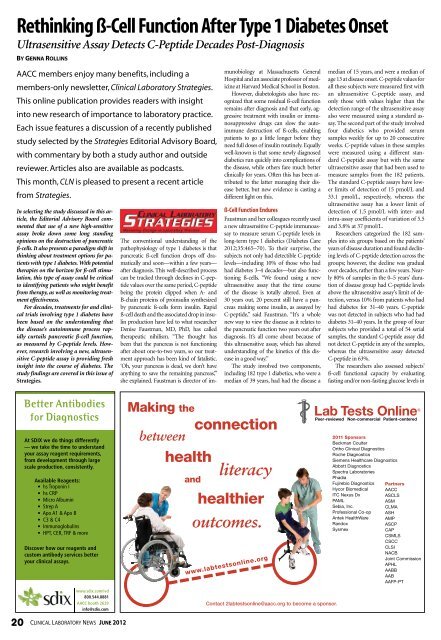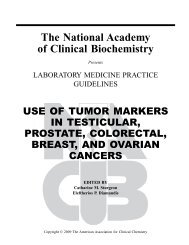June 2012 - American Association for Clinical Chemistry
June 2012 - American Association for Clinical Chemistry
June 2012 - American Association for Clinical Chemistry
You also want an ePaper? Increase the reach of your titles
YUMPU automatically turns print PDFs into web optimized ePapers that Google loves.
Rethinking ß-Cell Function After Type 1 Diabetes Onset<br />
Ultrasensitive Assay Detects C-Peptide Decades Post-Diagnosis<br />
By Genna Rollins<br />
aaCC members enjoy many benefits, including a<br />
members-only newsletter, <strong>Clinical</strong> Laboratory Strategies.<br />
this online publication provides readers with insight<br />
into new research of importance to laboratory practice.<br />
each issue features a discussion of a recently published<br />
study selected by the Strategies editorial advisory board,<br />
with commentary by both a study author and outside<br />
reviewer. articles also are available as podcasts.<br />
this month, CLN is pleased to present a recent article<br />
from Strategies.<br />
In selecting the study discussed in this article,<br />
the Editorial Advisory Board commented<br />
that use of a new high-sensitive<br />
assay broke down some long standing<br />
opinions on the destruction of pancreatic<br />
ß-cells. It also presents a paradigm shift in<br />
thinking about treatment options <strong>for</strong> patients<br />
with type 1 diabetes. With potential<br />
therapies on the horizon <strong>for</strong> ß-cell stimulation,<br />
this type of assay could be critical<br />
to identifying patients who might benefit<br />
from therapy, as well as monitoring treatment<br />
effectiveness.<br />
For decades, treatments <strong>for</strong> and clinical<br />
trials involving type 1 diabetes have<br />
been based on the understanding that<br />
the disease’s autoimmune process rapidly<br />
curtails pancreatic ß-cell function,<br />
as measured by C-peptide levels. However,<br />
research involving a new, ultrasensitive<br />
C-peptide assay is providing fresh<br />
insight into the course of diabetes. The<br />
study findings are covered in this issue of<br />
Strategies.<br />
Better Antibodies<br />
<strong>for</strong> Diagnostics<br />
At SDIX we do things differently<br />
— we take the time to understand<br />
your assay reagent requirements,<br />
from development through large<br />
scale production, consistently.<br />
Available Reagents:<br />
• hs Troponin I<br />
• hs CRP<br />
• Micro Albumin<br />
• Strep A<br />
• Apo A1 & Apo B<br />
• C3 & C4<br />
• Immunoglobulins<br />
• HPT, CER, TRF & more<br />
Discover how our reagents and<br />
custom antibody services better<br />
your clinical assays.<br />
www.sdix.com/ivd<br />
800.544.8881<br />
AACC booth 2629<br />
info@sdix.com<br />
20 CliniCal laboratory news <strong>June</strong> <strong>2012</strong><br />
The conventional understanding of the<br />
pathophysiology of type 1 diabetes is that<br />
pancreatic ß-cell function drops off dramatically<br />
and soon—within a few years—<br />
after diagnosis. This well-described process<br />
can be tracked through declines in C-peptide<br />
values over the same period, C-peptide<br />
being the protein clipped when A- and<br />
B-chain proteins of proinsulin synthesized<br />
by pancreatic ß-cells <strong>for</strong>m insulin. Rapid<br />
ß-cell death and the associated drop in insulin<br />
production have led to what researcher<br />
Denise Faustman, MD, PhD, has called<br />
therapeutic nihilism. “The thought has<br />
been that the pancreas is not functioning<br />
after about one-to-two years, so our treatment<br />
approach has been kind of fatalistic.<br />
‘Oh, your pancreas is dead, we don’t have<br />
anything to save the remaining pancreas’,”<br />
she explained. Faustman is director of im-<br />
munobiology at Massachusetts General<br />
Hospital and an associate professor of medicine<br />
at Harvard Medical School in Boston.<br />
However, diabetologists also have recognized<br />
that some residual ß-cell function<br />
remains after diagnosis and that early, aggressive<br />
treatment with insulin or immunosuppressive<br />
drugs can slow the autoimmune<br />
destruction of ß-cells, enabling<br />
patients to go a little longer be<strong>for</strong>e they<br />
need full doses of insulin routinely. Equally<br />
well-known is that some newly diagnosed<br />
diabetics run quickly into complications of<br />
the disease, while others fare much better<br />
clinically <strong>for</strong> years. Often this has been attributed<br />
to the latter managing their disease<br />
better, but new evidence is casting a<br />
different light on this.<br />
ß-Cell Function Endures<br />
Faustman and her colleagues recently used<br />
a new ultrasensitive C-peptide immunoassay<br />
to measure serum C-peptide levels in<br />
long-term type 1 diabetics (Diabetes Care<br />
<strong>2012</strong>;35:465–70). To their surprise, the<br />
subjects not only had detectible C-peptide<br />
levels—including 10% of those who had<br />
had diabetes 3–4 decades—but also functioning<br />
ß-cells. “We found using a new<br />
ultrasensitive assay that the time course<br />
of the disease is totally altered. Even at<br />
30 years out, 20 percent still have a pancreas<br />
making some insulin, as assayed by<br />
C-peptide,” said Faustman. “It’s a whole<br />
new way to view the disease as it relates to<br />
the pancreatic function two years out after<br />
diagnosis. It’s all come about because of<br />
this ultrasensitive assay, which has altered<br />
understanding of the kinetics of this disease<br />
in a good way.”<br />
The study involved two components,<br />
including 182 type 1 diabetics, who were a<br />
median of 39 years, had had the disease a<br />
Making the<br />
connection<br />
between<br />
health<br />
and<br />
literacy<br />
healthier<br />
outcomes.<br />
www.labtestsonline.org<br />
Contact 2labtestsonline@aacc.org to become a sponsor.<br />
median of 15 years, and were a median of<br />
age 13 at disease onset. C-peptide values <strong>for</strong><br />
all these subjects were measured first with<br />
an ultrasensitive C-peptide assay, and<br />
only those with values higher than the<br />
detection range of the ultrasensitive assay<br />
also were measured using a standard assay.<br />
The second part of the study involved<br />
four diabetics who provided serum<br />
samples weekly <strong>for</strong> up to 20 consecutive<br />
weeks. C-peptide values in these samples<br />
were measured using a different standard<br />
C-peptide assay but with the same<br />
ultrasensitive assay that had been used to<br />
measure samples from the 182 patients.<br />
The standard C-peptide assays have lower<br />
limits of detection of 15 pmol/L and<br />
33.1 pmol/L, respectively, whereas the<br />
ultrasensitive assay has a lower limit of<br />
detection of 1.5 pmol/L with inter- and<br />
intra-assay coefficients of variation of 5.5<br />
and 3.8% at 37 pmol/L.<br />
Researchers categorized the 182 samples<br />
into six groups based on the patients’<br />
years of disease duration and found declining<br />
levels of C-peptide detection across the<br />
groups; however, the decline was gradual<br />
over decades, rather than a few years. Nearly<br />
80% of samples in the 0–5 years’ duration<br />
of disease group had C-peptide levels<br />
above the ultrasensitive assay’s limit of detection,<br />
versus 10% from patients who had<br />
had diabetes <strong>for</strong> 31–40 years. C-peptide<br />
was not detected in subjects who had had<br />
diabetes 31–40 years. In the group of four<br />
subjects who provided a total of 54 serial<br />
samples, the standard C-peptide assay did<br />
not detect C-peptide in any of the samples,<br />
whereas the ultrasensitive assay detected<br />
C-peptide in 63%.<br />
The researchers also assessed subjects’<br />
ß-cell functional capacity by evaluating<br />
fasting and/or non-fasting glucose levels in<br />
2011 Sponsors<br />
Beckman Coulter<br />
Ortho <strong>Clinical</strong> Diagnostics<br />
Roche Diagnostics<br />
Siemens Healthcare Diagnostics<br />
Abbott Diagnostics<br />
Spectra Laboratories<br />
Phadia<br />
Fujirebio Diagnostics<br />
Hycor Biomedical<br />
ITC Nexus Dx<br />
PAML<br />
Sebia, Inc.<br />
Professional Co-op<br />
Antek HealthWare<br />
Randox<br />
Sysmex<br />
Partners<br />
AACC<br />
ASCLS<br />
ASM<br />
CLMA<br />
ASH<br />
AMP<br />
ASCP<br />
CAP<br />
CSMLS<br />
CSCC<br />
CLSI<br />
NACB<br />
Joint Commission<br />
APHL<br />
AABB<br />
AAB<br />
AAFP-PT
















